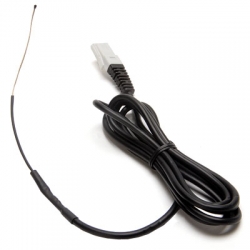
Enlarge

Enlarge
Vernier Surface Temperature Probe
Order code: STS-BTA
VERNIER SURFACE TEMPERATURE PROBE
Vernier's Surface Temperature Sensor is designed for use in situations in which low thermal mass or flexibility is required, or for a skin temperature measurement. It has an exposed thermistor that results in an extremely rapid response time. This design allows for use in air and water. For temperature measurements in harsher environments that require a more durable probe we recommend Vernier's TMP-BTA Stainless Steel Temperature Probe.
Typical uses for the Surface Temperature Sensor include:
• Skin temperature measurements
• Human respiration studies
• Specific heat experiments
• Heat transfer experiments
• Friction and energy studies
Requirements:
This sensor requires suitable software and an interface such as one of the Vernier LabQuest variations or Vernier Go-Link.
For comprehensive details of the possible sensor/interface/software combinations see the Compatibility Guide link below.
Specifications:
• Temperature range: –25° to 125°C
• Maximum temperature that the sensor can tolerate without damage: 150°C
• Typical Resolution:
0.08°C (–25 to 0°C)
0.03°C (0 to 40°C)
0.1°C (40 to 100°C)
0.25°C (100 to 125°C)
• Temperature sensor: 20 kΩ NTC Thermistor
• Accuracy: ±0.2°C at 0°C, ±0.5°C at 100°C
• Response time (time for 90% change in reading)
50 seconds (in still air)
20 seconds (in moving air)
• Probe dimensions: Probe length (handle plus body) 15.5 cm
Important: For use in air and water only. For temperature measurements in harsher environments we recommend the Stainless Steel Temperature Sensor.
| User Manual | Vernier Surface Temperature Sensor | ||
Educational use only:
Vernier and Kidwind products are designed for educational use. They are not appropriate for industrial, medical or commercial applications. Details
Warranty
- Warranty: 5 year limited warranty
Dimensions- Package size (HxWxD): 25x127x203mm
- Packed weight: 50g
Last edited 9th Jan 2025
 This product is used in teaching these Australian Curriculum codes:
This product is used in teaching these Australian Curriculum codes:
ACSSU049 - Physical Sciences - Heat - Heat can be produced in many ways and can move from one object to another
ACSSU182 - Physical Sciences - Energy Transfer - Energy transfer through different mediums can be explained using wave and particle models
Click a curriculum code to see other products that relate.
| Works with: | From |
| LABQ2 - Vernier LabQuest 2 Data Logger and Interface | |
| LQ-MINI - Vernier LabQuest Mini Data Logger Interface | $470.00 |
| GA4 - Vernier Graphical Analysis | |
| GO-LINK - Vernier Go!Link Data Logger Interface with Logger Lite Software | $186.00 |
| REV - Renewable Energy with Vernier | $147.00 |
| ELB-SOLAR - Vernier Investigating Solar Energy | $67.00 |
| HP-A - Human Physiology with Vernier | $125.00 |
| EPV - Vernier Engineering Projects with NI LabVIEW and Vernier | $117.00 |
| Similar Products: | From |
| GDX-TMP - Vernier Go Direct Temperature Probe | $196.00 |
| GO-TEMP - Vernier Go!Temp Data Logger Temperature Probe with Logger Lite Software | $122.00 |
| TMP-BTA - Vernier Stainless Steel Temperature Probe | $112.00 |
| TCA-BTA - Vernier Thermocouple | $196.00 |
| TPL-BTA - Vernier Extra Long Temperature Probe | $246.00 |
| WRT-BTA - Vernier Wide Range Temperature Probe | $296.00 |
| EZ-TMP - Vernier Easy Temp | $119.00 |
Documents: Catalogue | Vernier Catalogue K-12 | Catalogue | Vernier Catalogue Uni | Catalogue | Scientrific April 2025 Mini Catalogue | Catalogue | Vernier 2025 K-12 Catalogue | Catalogue | Vernier 2025 University Catalogue | Compatibility Guide | Sensor-Interface-Software Requirements (external link) | Experiment | Vascularity Skin Temperature | User Manual | Vernier Surface Temperature Sensor | | |||||||||||||||||
Note: Prices do NOT include GST or freight


